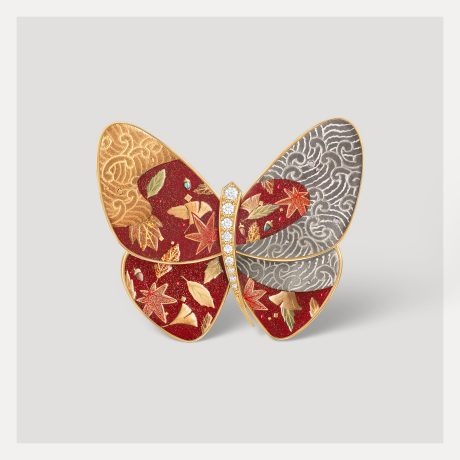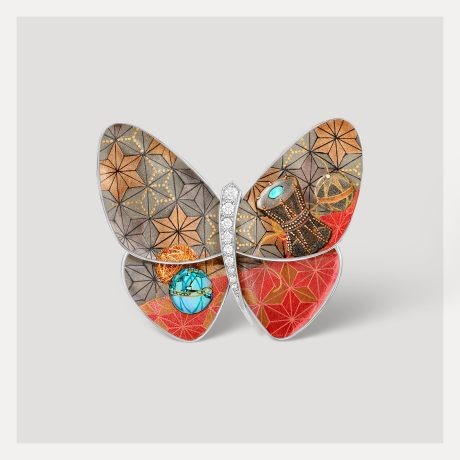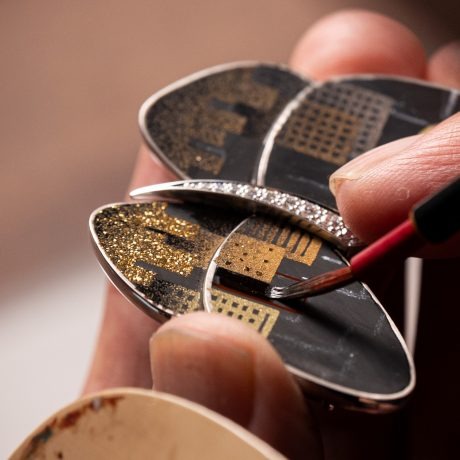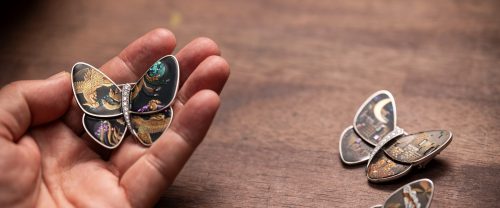In the realm of high jewelry and fine art, a unique fusion between French elegance and Japanese tradition has been flourishing for nearly half a century. The esteemed French maison Van Cleef & Arpels, with a storied history that stretches back to its founding in 1906, has woven a deep and intricate bond with the rich tapestry of traditional Japanese art and culture since establishing its first boutique in Japan in 1973. This bond has evolved over the decades, growing into a vibrant dialogue that seamlessly blends the decorative arts of France with the ancient artistic craftsmanship of Japan.

@Van Cleef & Arpels
The year 2004 marked a significant milestone in this cultural exchange when Van Cleef & Arpels’ iconic motif, the butterfly, was reimagined through the lens of lacquer art. This reinterpretation gave birth to the lacquered Butterfly clip, a masterpiece born from the collaboration with Junichi Hakose, a visionary artist from Wajima City, Ishikawa Prefecture. Hakose, in his workshop, marries the traditional Wajima-nuri lacquer technique with a contemporary aesthetic, incorporating elaborate elements such as maki-e (a technique of sprinkling gold or silver powder) and raden (mother-of-pearl inlay) to create pieces that resonate with both Van Cleef & Arpels’ commitment to tradition and the métiers d’art.

@Van Cleef & Arpels
The collection of lacquered butterflies has since burgeoned, enriched by an ever-evolving array of designs that symbolize the harmonious fusion of French heritage and Japanese craftsmanship. This collaboration was put to the test when an earthquake in January caused significant damage to Hakose’s workshop. Despite the devastation, the bond between the Maison and the artist remained unshaken, with Van Cleef & Arpels extending unwavering support to aid in the recovery and rebuilding efforts.
Nicolas Bos, President and CEO of Van Cleef & Arpels, expressed his deep respect for the two-decade-long partnership with Hakose, highlighting the Maison’s commitment to preserving and supporting traditional craftsmanship. This collaboration is not merely a meeting of two cultures but a vibrant, ongoing conversation that brings together the worlds of jewelry and traditional Japanese culture in a unique way. After being crafted in France from precious materials such as yellow and white gold, mother-of-pearl, and diamonds, these butterflies are sent to Hakose to be adorned with Japanese lacquer and decorated using the maki-e technique.

@Van Cleef & Arpels
Over the past 20 years, this dialogue between French and Japanese cultures has led to the continuous evolution of the lacquered butterflies, reflecting a blend of reducing and adding features, as noted by Hakose. This intercultural exchange has resulted in designs that not only pay homage to traditional Japanese patterns but also embrace modern themes, including urban landscapes and architectural scenes, reflecting Hakose’s belief in the storytelling power of art.
The lacquered butterflies, each a testament to the universal appeal of this collaboration, showcase Hakose’s modern interpretation of traditional Japanese motifs, alongside new designs inspired by contemporary life and celebrations. The meticulous craftsmanship required to bring these designs to life, from arranging eggshell fragments for specific patterns to drawing with ultra-thin brushes, underscores the expertise and dedication behind these creations.

@Van Cleef & Arpels
As these lacquered butterflies continue to captivate audiences worldwide, they serve as a symbol of the enduring relationship between Japan and France, a testament to the ongoing metamorphosis of traditions. Through this collaboration, Van Cleef & Arpels and Junichi Hakose not only celebrate the beauty of blending cultures but also chart a path for the future, where traditions are not merely preserved but are also reinterpreted and revitalized for new generations. As these exquisite pieces flutter into the hearts and homes of people around the globe, they carry with them a story of resilience, creativity, and the unbreakable bond between two distant, yet intimately connected, worlds.

